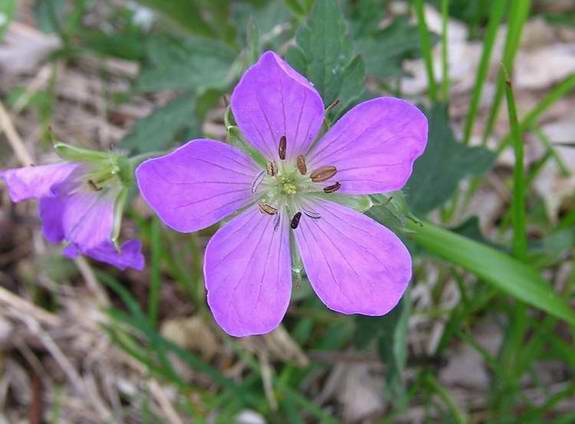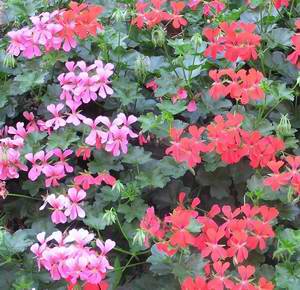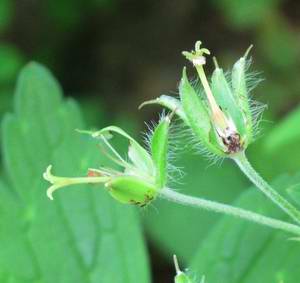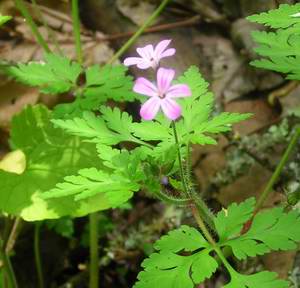|
Return to Hiker's Notebook Home Page
Common Name: Wild Geranium, Cranesbill, Spotted geranium, Storksbill, Alum bloom, Old Maid's Nightcap, Rockweed - The common name is taken directly from the genus and is distinguished as wild to differentiate it from the many cultivated varieties.
Scientific Name: Geranium maculatum - The generic name is derived from the Greek geranos which means 'crane' in reference to the seed case of the flower which is likened to the bill of a crane. The species name is from the Latin 'macula' which means spotted; the leaves are sometimes speckled with brown spots.
There is some irony in the use of Wild Geranium to distinguish the native species from the many other flowers that are generally referred to as geraniums even though they are not even in the Geranium genus. The rationale is the ubiquity of the root 'gerania' for the genus Geranium, the family Geraniaceae, and the order Geraniales. The Geranium order is comprised of 20 families with about 140 genera and over 4,000 species and includes the Geranium family has about 10 genera with 800 species. Presumably, many of these species could be called the wild geranium as some are by definition wild somewhere.
The commercial geranium that is one of the mainstays of the horticulture trade
is in the genus
The native African geraniums are also commercially important for the production of geranium oil, which is also known as pelargonium oil and rose-geranium oil. Most of the oils are from the two species P. graveolens and P. odorantissimum which are named according to their olfactory excrescences; graveolens means 'strong-smelling or rank' and odorantissimum means 'smelling most of all' in Latin. The odiferous flowers yield an essential oil with a rose-like aroma when extracted through steam distillation. The slightly green oleaginous fluid is used in perfumes, soaps, dusting powders and body lotions. It is extolled in the herbal marketplace for its properties, which are subject to a certain amount of hyperbole. Geranium essential oil is variously considered an astringent for skin contraction, an anti-bacterial vulnerary that helps to heal wounds, a deodorant that masks unpleasant body odors, and a vermifuge that gets rid of intestinal worms among many others. These many attributes that have the seemingly impossible curative powers that were once claimed by the iconic snake oil salesman are attributed to a number of the chemical constituents of geranium oil, notably Alpha Pinene, Menthone, Geranyl Acetate and Geraniol.
The medicinal properties of commercially cultivated geraniums are not as widely exaggerated as they may sound, as the so-called Wild Geranium of our native woodlands has long been used for a diverse assortment of ailments by Native Americans. Ethno-botanical databases yield about thirty different specific uses spread across seven tribal groups against distinct maladies. Though the whole plant was sometimes decocted to extract the essence, more typically the root, which consists of 10 to 20 percent tannin, was dried and administered in a powdered form as either a tonic or as a topical plaster application. Geranium extract was used by the Cherokee, Iroquois, Chippewa and Ojibwa as a throat wash for children to treat a condition known as 'thrush' which is caused by fungi of the genus Candida that induces white lesions on the mouth and throat, the astringent properties of the drug checking the secretions of the festering sores. The tonic properties of geranium were also used widely in the treatment of diarrhea and other bowel related problems, (including hemorrhoids according to Meskwaki Indian sources). Among the more interesting applications were its uses in the form of a poultice of chewed roots to treat the unhealed navels of babies, as a topical treatment for 'the venereal' and (by the Iroquois) as a root-tea antidote against a love potion.
The medicinal properties of the Wild Geranium became manifest to the early colonists through their interactions with the native cultures and the list of treatments to which it was applied expanded accordingly. The astringent and styptic properties of the tannin-rich plant were effective in the staunching of wounds whereas the powdered root was used for a wide variety of ailments, including dysentery, piles, gum disease, cholera, gonorrhea, neuralgia, toothache and gum disease. In the absence of any regulatory controls, it is uncertain as to whether it may have had anything more than a placebo effect. The Wild Geranium eventually became a popular medicinal export to Europe which contributed to its many descriptive mnemonic sobriquets. Alum Root or Alum Bloom is associated with the styptic properties, Old Maid's Nightcap and Shameface refer to the general shape and color of the flower, and Rockweed identifies is preference for rocky soils.
Herb Robert is a related species of geranium (G. robertianum) that has
similar medicinal properties, the common name a reflection its healing
potentiality. In addition to the geranial uses a as a styptic and as a gargle
for sore throat, Herb Robert has antibacterial properties that have been used
to treat vesicular stomatitis, an equine affliction similar to foot-and-mouth
disease. Among its
The geranium was one of the principle flowers studied by the German theologian and naturalist Christian Konrad Sprengel, an early proponent of pollination ecology. Though now a botanical tenet, the sexuality of flowers and the role of insect pollinators in their fertilization was not well understood until the 19th Century. His seminal work was published in Berlin in 1793 entitled "Discovery of the Secret of Nature in the Form and Fertilization of Flowers" when translated from the original German. The Zeitgeist of European theology is captured in the introduction:
"When I carefully examined the flower of the wood cranesbill (Geranium sylvaticum) in the summer of 1787, I discovered that the lower part of its corolla was furnished with fine, soft hairs on the inside of the margins. Convinced that the wise creator of nature had not created even a single tiny hair without definite purpose, I wondered what purpose the hairs might serve. And it soon came to my mind that if one assumes that the five nectar droplets which are secured by the same number of glands are intended as food for certain insects, one would at the same time not think it unlikely that provision had been made for this nectar not to be spoiled by rain and that these hairs had been fitted to achieve this purpose."
This led Sprengel's teleological conclusion that nectar was an enticement for insects that the flower used to promote fertilization, a 'botany of desire' according to the metaphor of Michael Pollan. The countervailing and prevailing notion of the time was that all flowers were self-fertilizing (as is the case with what we now call perfect flowers) and that nectar had to be removed by honeybees to prevent clogging. Sprengel's hypotheses supported Darwin's ideas of evolution by allowing for random genetic variation in plants that could then be subject to the survival of the fittest to create endless forms most beautiful." |

 Pelargonium, also of the Geranium family in the Geranium order. The
generic name in this case derives from the Greek pelargos which means
'stork' referring to the beak-like shape of the seed capsules, with the same
rationale that geranos or 'crane' is applied to the genus Geranium.
Pelargonium contains about 250 species which are primarily indigenous
to the tropics; however, most of the commercial geranium variants are native
to southern Africa. The flowers of the mostly hybrid cultivars marketed as
geraniums are typically characterized by their irregular petals; two having a
different size or color than the remainder, as seen in the photograph of
geraniums in a window box in Bavaria.
Pelargonium, also of the Geranium family in the Geranium order. The
generic name in this case derives from the Greek pelargos which means
'stork' referring to the beak-like shape of the seed capsules, with the same
rationale that geranos or 'crane' is applied to the genus Geranium.
Pelargonium contains about 250 species which are primarily indigenous
to the tropics; however, most of the commercial geranium variants are native
to southern Africa. The flowers of the mostly hybrid cultivars marketed as
geraniums are typically characterized by their irregular petals; two having a
different size or color than the remainder, as seen in the photograph of
geraniums in a window box in Bavaria.  The
common names Cranesbill and Storksbill have similar etymologies in reference
to the shape of the aril or seed covering that resembles the long and narrow
structure of a bird's bill. The structure of this appendage is such that the
seeds are ejected with enough force to propel them up to ten meters away from
the plant to promote dissemination, a process similar to that of the
The
common names Cranesbill and Storksbill have similar etymologies in reference
to the shape of the aril or seed covering that resembles the long and narrow
structure of a bird's bill. The structure of this appendage is such that the
seeds are ejected with enough force to propel them up to ten meters away from
the plant to promote dissemination, a process similar to that of the
 myriad other uses were as a folk treatment for cancer and as a poultice to
relieve swollen breast pain. The eponymous Robert for whom the flower is named
remains a mystery. Among the candidates are: Robert of Molesme, a 12th
Century French abbot canonized by Pope Honorius III whose Catholic feast date
of 17 April coincides with the appearance of the flower in Europe, Robert,
Duke of Normandy the father of William the Conqueror who became William I of
England following the defeat of King Harold's Saxons at the Battle of Hastings
in 1066; and Saint Rupert of Salzburg, who is thought to have discovered that
the herb plants were useful in the treatment of erysipelas, a skin condition
also known as St. Anthony's Fire. One reference postulates Robin Hood as the
eponym, though this is likely a bunyanesque extrapolation referring to the
notion that Robin Hood was really Robert, the Earl of Huntington. Herb
Robert is also known as Felonwort for its use in the treatment of felons (a
condition characterized by painful lesions on the fingers and toes - the same
word is used for a person who commits a felony as both are villainous), as
Fox Geranium for its red color, and Stinky Bob for its malodorous aroma.
myriad other uses were as a folk treatment for cancer and as a poultice to
relieve swollen breast pain. The eponymous Robert for whom the flower is named
remains a mystery. Among the candidates are: Robert of Molesme, a 12th
Century French abbot canonized by Pope Honorius III whose Catholic feast date
of 17 April coincides with the appearance of the flower in Europe, Robert,
Duke of Normandy the father of William the Conqueror who became William I of
England following the defeat of King Harold's Saxons at the Battle of Hastings
in 1066; and Saint Rupert of Salzburg, who is thought to have discovered that
the herb plants were useful in the treatment of erysipelas, a skin condition
also known as St. Anthony's Fire. One reference postulates Robin Hood as the
eponym, though this is likely a bunyanesque extrapolation referring to the
notion that Robin Hood was really Robert, the Earl of Huntington. Herb
Robert is also known as Felonwort for its use in the treatment of felons (a
condition characterized by painful lesions on the fingers and toes - the same
word is used for a person who commits a felony as both are villainous), as
Fox Geranium for its red color, and Stinky Bob for its malodorous aroma.